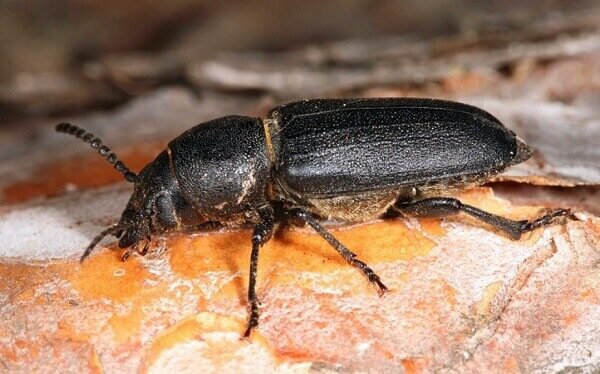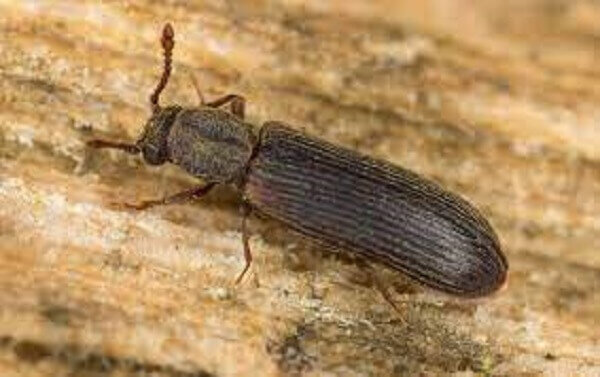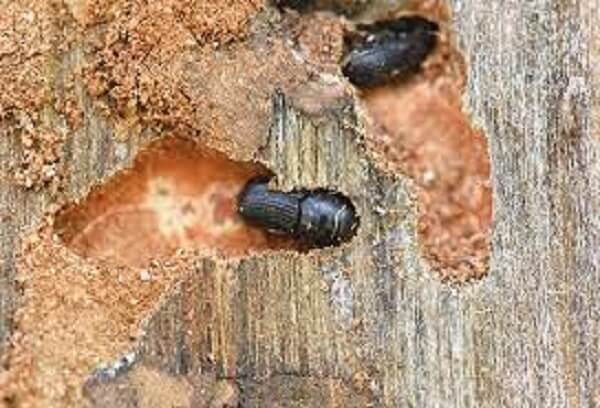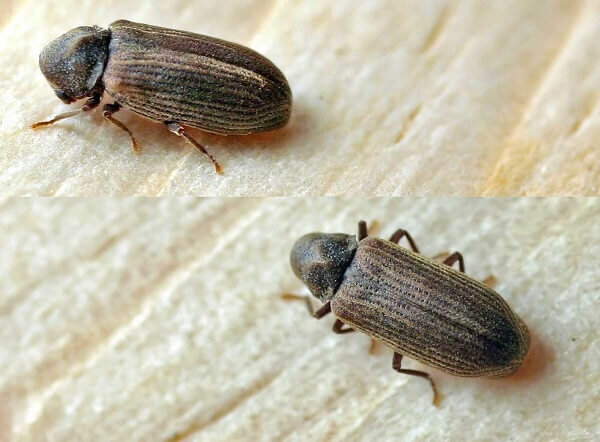You have lovely wood furniture, flooring or decking, and one day you notice damages caused by wood eaters? Woodworms alert!
Woodworm describes a number of species of wood-boring beetles that attack wood. The term “woodworm” is used as it is the larval or “worm” stage of the insects’ life where they bore and eat wood
Wood damaging pests can attack expensive antiques and even a building’s structural components. Wood pests have managed to develop an astonishing variety of life forms, and can even live comfortably in totally dry wood.
For most of the devils listed below, we recommend the natural treatment made by our friends from Freemite.
For more advice about how to get rid of wood borers, we suggest this well-written guide.
And, since there are unfortunately a lot of these wood buggers, we will have to divide this guide in two parts.
Woodboring Weevil
Appearance
Adults are 2.5 to 5mm in length. The weevils are reddish brown to black. They have a long snout, a cylindrical body and short legs. The larvae are a creamy white C-shaped, wrinkled and legless.
Lifecycle
Eggs are laid singly by the female in specially evacuated holes. They are glossy, white, flexible and flattened at one end and they hatch within 16 days. The larvae tunnel in the wood for between six months and a year. They pupate near the surface for between two to three weeks.
The adult emerges in the summer by boring its way leaving exit holes. The adults may live for over a year.
Habits
Damage is associated with damp and decaying wood, particularly timber already rotted by cellar fungus. Infestations can spread to adjacent healthy wood.
Bamboo Borer
Appearance
The bamboo beetle has a dark brown body, plump, almost cylindrical, 2 to 3.7 mm in length.
Antennae broaden at the tip, with the last 3 segments considerably larger and ending in well-defined antenna clubs.
The humped thorax conceals the head and has teeth-like indentations in its rounded front. Two large dimples at the back of the thorax.
Elytra (wing cases) are covered with small pits and bristly hairs.
Lifecycle
The female lays 27–35 eggs into the food substrate, larvae hatch and bore into the plant.
Larva undergoes up to 4 development phases and pupates inside the plant.
The lifecycle can be as short as 60 days in good conditions (35 °C, 75% relative humidity) leading to multiple generations per year.
Habits
Larva feeds on bamboo cane, but the weevil is also known to breed on cassava root.
Larva makes tubular passages along plant fibres and emerges leaving a perfectly round hole.
Powderpost Beetle
Appearance
The adult powderpost beetles are on average 5 mm in length.
They are red brown, narrow and somewhat flattened.
The larvae are creamy white and measure 6mm when fully developed.
Lifecycle
Whitish, long and cylindrical eggs are laid by the female into the wide pores of hardwoods. She lays between 30 and 50 eggs, which hatch in one or two weeks. They are laid only if the starch content of the wood is high enough for the larvae.
The larvae pupate for between two and four weeks near the surface. The adult emerges by biting its way out between June and August.
The whole life cycle may take between four and ten years.
Powderpost beetle life cycle - Queensland Department of Primary Industries
Habits
Of the four distinct life stages, the larvae do the most damage to wood. They will tunnel in the wood for between one or two years.
They are primarily pests of timber yards, but also cause considerable damage to furniture, sports equipment, wood block floors and joinery.
Bark Borer
Appearance
The adult bark beetles are on average 3–6mm. Red or chestnut brown with yellow silky hairs on body.
Lifecycle
Female lays 20-30 eggs in bark crevices which hatch into larvae in two to three weeks.
Pupation follows in spring or early summer, lasting one or two weeks.
Adults emerge between May and August.
Habits
Damage confined to unbarked softwoods, causing no structural damage. Occurs on pergolas, rustic work, fence posts and garden sheds.
Common Furniture Beetle
Appearance
The adult common furniture beetles are on average 3–4 mm in length. Thorax is significantly humped concealing the head.
Larva – usually concealed in wood.
Lifecycle
Optimum conditions for development are 22–23°C.
Habits
Not regarded as a pest of stored products, but is timber related






